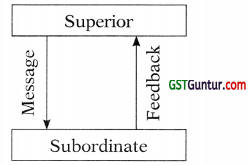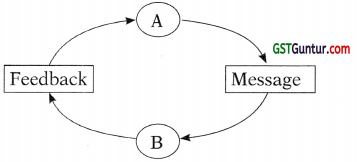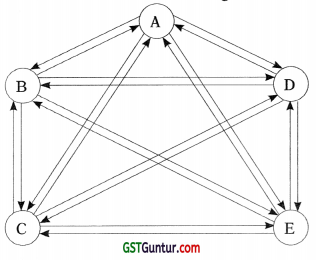This Communication – BCR CA Foundation Study Material is designed strictly as per the latest syllabus and exam pattern.
Communication – BCR CA Foundation Study Material
Question 1.
What is communication? Explain the elements of the communication process.
Answer:
Communication is defined as the process of sharing (exchanging) information, ideas, thoughts, feelings, and emotions between two or more persons.
Process of Communication
The communication process consists of the following elements:

- Sender: The sender is the person who initiates the process of communication. The sender may be a speaker, a writer, an actor, a painter, etc.
- Encoding: The process of converting the message into words, symbols, pictures, etc. is called encoding.
- Message: Message means whatever is to be communicated. It is the heart of the communication process.
- Channel: The medium through which the message is sent is called a channel. It may be a speech, a letter, an e-mail, SMS, gesture, sound, etc.
- Receiver: The person to whom the message is sent is the receiver. The receiver may be a listener, a reader, or a viewer
- Feedback: The reaction or response to the message is called feedback
- Noise: Any disturbance, hurdle, or barrier to communication is noise.
![]()
Question 2.
What are the various types of communication networks?
Answer:
The pattern used to share information is known as a communication network. The main types of communication networks are given below:
1. VERTICAL NETWORK: This network is used for communication between a superior and a subordinate. It is two-way communication in which immediate feedback can be available

2. CIRCUIT NETWORK: When two employees at the same level of authority communicate with each other, it is a circuit network.

3. CHAIN NETWORK: In this network, communication flows through the chain of command. The message flows from the chief executive downward to different levels of employees. In the following, diagram A gives commands to B, C, D, E, F, and G working at different levels in the hierarchy. In chain network communication gets delayed as it has to pass through several layers. Communication may be distorted due to filtering at various levels.

4. WHEEL: In this network, a single authority gives orders and instructions to all the employees around him. They also report directly to him. This network may be efficient for a small organization provided the central authority is competent. But in a large organization, all decisions cannot be taken by one person.

5. STAR NETWORK: In this network members of an organization communicate through multiple channels. They exchange information with each other freely without any obstacles. Star network encourages group communication and teamwork in the organization.

Question 3.
What is meant by non-verbal communication?
Answer:
Communication without using words is called non-verbal communication. Non-verbal communication may take the following forms:
(a) Body Language: Communication through facial expressions, gestures, stance, touch, and other physical signs is called body language. For example, leaning forward may indicate interest and acceptance whereas leaning backward may mean rejection and lack of interest. Body language (e.g. smile, frown, clenching of hands, etc. can transmit emotions that cannot be expressed through words. Body language constitutes a major part (about 55 percent) of all communication.
(b) Paralanguage: Pitch, tone, quality, etc. of voice is known as paralanguage. The way one speaks, rather than words, reveals the intent of the speaker. Paralanguage constitutes about 38 percent of all communications.
(c) Aesthetics: Music, dancing, painting sculpture, and other forms of art serve as means of communication. These convey the feelings and thoughts of artists.
(d) Appearance: Dress and grooming create the first impression. In offices, there is a dress code. Formal dress for men may consist of shirt, trousers, coat and leather shoes. For women, it may consist of a saree, suit, shirt, trouser, or skirt.
(e) Symbols: Symbols may relate to religion, status, ego, etc. These convey a special meaning. For example, the number of stars on the shirt of a police officer reveals his/her status.
![]()
Question 4.
What are the barriers to communication?
Answer:
The various barriers in communication may be classified as under:
1. Language or Semantic Barriers: Difficult words, ambiguous words, jargon (terminology used in a specific field e.g. medical science), unfamiliar expressions have several meanings. People from different regions and nations may interpret the same words in different ways. Therefore, clear, simple, and easily understandable language should be used in communication.
2. Physical Barriers: These barriers arise due to noise, faulty equipment, distant locations, outdated technology, and lack of good infrastructure.
3. Technology Barriers: Anyone who is not familiar with modern communication technology (video conference, e-mail, SMS, WhatsApp, etc.) may fail to communicate effectively.
4. Physiological Barriers: Poor eyesight, difficulty in hearing, ill-health, and other such problems act as hurdles in communication.
5. Organizational Barriers: When the chain of command is unclear, an employee may not know whom to contact for a particular matter. Rigid and ambiguous structures, systems, and processes in an organization also hamper effective communication. Unclear roles and responsibilities cause confusion.
6. Cultural Barriers: People belonging to different cultures derive different meanings from the same message. People working in multinationals have to communicate with persons from different cultures. Lack of understanding of alien cultures inhibits communications. In this era of globalization, it is essential to understand cultural differences to communicate effectively.
7. Gender Barriers: Men and women often communicate in different ways. Men tend to talk in a logical and linear manner whereas women tend to use both logical emotions and are verbose. Men may blame women for transmitting too much information. Similarly, women may blame men for giving inadequate information. Gender bias is another barrier in communication. Male employees with the traditional mindset may find it difficult to take orders from a female boss.
8. Perception Barriers: Everyone perceives things in different ways. Two persons may interpret the same event/object differently. Differences in perception lead to miscommunication.
9. Emotional Barriers: Anger, jealousy, anxiety, lack of trust, fear of criticism, and similar feelings/sentiments hinder free and open communication. A disturbed or upset individual can neither convey nor receive information objectively.
10. Attitude Barriers: A shy introvert, lazy or frustrated worker cannot communicate effectively.
Question 5.
What are the essentials of Effective Communication? or What are the ‘7Cs’ of Communication? or Characteristics of Effective Communication.
Answer:
1. Clarity: The message must be expressed in simple and easy-to-understand language. Short sentences should be used and each idea must be stated in a separate paragraph.
2. Conciseness: Only necessary and relevant words must be used. Brevity is the essence of effective communication. There should be no repetitions & unnecessary words in the message.
3. Completeness: The message must be complete as omissions of necessary. facts create confusion and misunderstanding
4. Concreteness: Use facts and figures in place of abstract ideas. The mes¬sage must be expressed in precise words.
5. Coherence: Different elements of the message must be organized in a sequential and logical way. Words, sentences, and paragraphs must be inter-connected and there should be a smooth flow of information.
6. Courtesy: The sender of the message must take into consideration the feelings and viewpoints of the receiver. He should be polite, respectful, and honest. The message and its tune must not be offensive.
7. Correctness: The message must be accurate in all respects.
8. Attention and Listening: The receiver must pay full attention to the message. He should not only listen to the spoken words but also carefully observe the speaker’s body language. In the case of written messages, the reader must read between the lines.
9. Emotional Awareness & Control: Managing your own & other emotions & communicating keeping in mind the emotional state of others helps in smooth interaction & prevents the breakdown of the communication process.
![]()
Question 6.
Differentiate between the following:
- Formal & Informal Communication
- Written & Oral Communication
Answer:
1. Formal & Informal Communication
| Basis & Distinction | Formal Communication | Informal communication |
| Meaning | A type of verbal Communication whereby the exchange of information takes place through predefined & formally established channels in the organization. It is also known as Official Communication. | A type of verbal as well as non-verbal communication in which the exchange of information does not follow any predefined & established channels in the organization. It is also known as Grapevine Communication. |
| Reliability | it is more reliable in nature since it takes place through formally authorized channels. | It is less reliable in comparison to formal communication. |
| Speed | This type of Communication is time-consuming and slow. | It is less time-consuming and very fast. |
| Secrecy | Full secrecy is maintained and assured informal Communication. | It is difficult to maintain secrecy in this type of Communication. |
| Disadvantage | There is a possibility of distortion due to the filtration of information as it moves up and down the chain of hierarchy. | There is a possibility of distortion of information on account of the spread of rumors and gossips. |
| Advantage | Since control can be exercised on formal channels of communication, this type of communication is more effective and is able to meet organizational objectives. | This type of Communication is efficient since employees can discuss their problems openly and this saves time and cost for the organization. |
| Evidence | As this Communication is generally written, documentary evidence is present. | This Communication is generally oral and is supported by non-verbal Communication, no documentary evidence is present. |
2. Written & Oral Communication
| Basis Distinction | Written Communication | Oral Communication |
| Meaning | interchange of ideas, messages, and information through words in writing is said to be written Communication. | The exchange of ideas, information, and messages through spoken words is said to be oral communication. |
| Literacy | Since this communication requires written words, literacy is necessary for communication. | Since this communication takes place through spoken words i.e. words of the month, literacy is not imperative. |
| Speed | The transmission of the message takes place slowly. | The transmission of messages is quick & speedy. |
| Evidence | Written communication involves proper records & documents. | There are no records in the case of oral communication. |
| Reference | Since this Communication is well documented it can be retained and referred to in the future. | Since there is no record of this type of Communication it cannot: be referred to in the future. |
| Feedback | The feedback generated in the case of written Communication takes time. | The feedback in the case of oral communication is prompt and immediate. |
Question 7.
What are the main steps in the process of communication?
Answer:
Steps in the process of communication
- The purpose of reason
- The content or message
- The medium used for conveying the message (internet, written text, speech, etc.)
- Transmitting the message
- Messages are often misinterpreted due to external disturbances. These factors disrupt communication
- Receiving the message
- Deciphering/decoding the message
- Interpreting and figuring out what the real message is.
![]()
Question 8.
What is diagonal communication?
Answer:
Diagonal Communication.
It is part of the formal communication section. It refers to the cross-functional communication between different levels of employees in an organization. It is commonly found in large organizations. Diagonal communication is recommended as it reduces the gaps between communication and encourages direct talks with the third party. For example, a junior engineer directly reporting to the General Manager about the progress of a project.
Question 9.
Define visual communication.
Answer:
(a) Visual communication
Communication that happens through visual aids such as signs, graphic designs colors, illustrations, etc. is visual communication. It is a powerful medium these days, especially for office presentations. Visuals can also include pie charts, graphs, or any other colorful representation. It adds value to the content and forms a major part of audiovisual ppts.